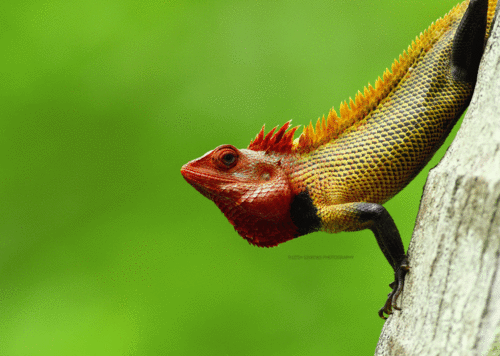
Description:
Scientific name: Calotes versicolor
Life span: 5 years
Calotes versicolor, an agamid lizard that is extensively spread in Indo-Malaya, is also known as the oriental garden lizard, eastern garden lizard, Indian garden lizard, common garden lizard, bloodsucker, or changeable lizard.
The lizard’s background colour can shift to a bright red, a deep black, or a combination of the two. Its typical hue is a light brownish olive. Sometimes this alteration is limited to the head, while other times it affects the entire body and tail. The male’s head and shoulders turn bright orange to crimson and his throat turns black during the breeding season. In addition, males develop red hair after defeating opponents. The “Crested Tree Lizard” moniker refers to the fact that both men and females have a crest that extends from their heads to almost their tails.
Native Region/Habitat
Southeast Iran, Bangladesh, Afghanistan, Bhutan, China, Cambodia, India, Malaysia, Maldives, Indonesia, Mauritius, Nepal, Myanmar, Pakistan, Philippines, Sri Lanka, Thailand, and Vietnam are among the places where Oriental garden lizards are found. These lizards can be found in a variety of settings and seem to get along well with people. They frequently inhabit the underbrush in open settings, including densely populated regions.

Behavior:
The majority of the time, oriental garden lizards hide in low shrubs and tree trunks to avoid being seen. They are solitary and nocturnal; on a hot, bright day, they are frequently spotted sitting on a branch or perched on a wall, soaking up the rays with their mouths open. Several of these lizards may descend to the ground following a rainstorm to collect the larva and tiny insects that have fallen from the trees. The teeth of oriental garden lizards are intended for grasping rather than tearing apart prey. As a result, they swallow their prey whole after shaking it to stun it.
Care As a pet/In captivity:
The terrarium must be somewhat large. 180–200 cm in length, 130 cm in height, and 70 cm in depth. In theory, the terrarium caretaker can design the tank anyway they choose. The relative humidity must not be lower than 70%, and there must be plenty of area to ascend. Lizards require temperatures of about 40 °C in the warmest environment.
There must only be one male present in each terrarium to prevent murder and manslaughter. While 2-3 females can be kept in the terrarium, it is safest to keep them in pairs.
The Oriental garden lizard can eat any live food available on the market that is appropriate for its size, however newborn mice are only occasionally utilized, if at all. Of course, a diversified and consistently well-pollinated diet is necessary. Plants that are acceptable can be grown in the terrarium, ideally in pots, to offset the minimal requirement for plant food.
Table





